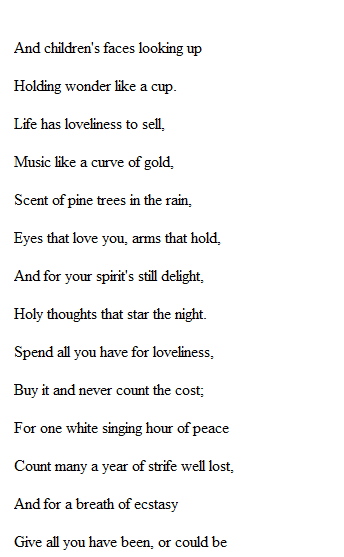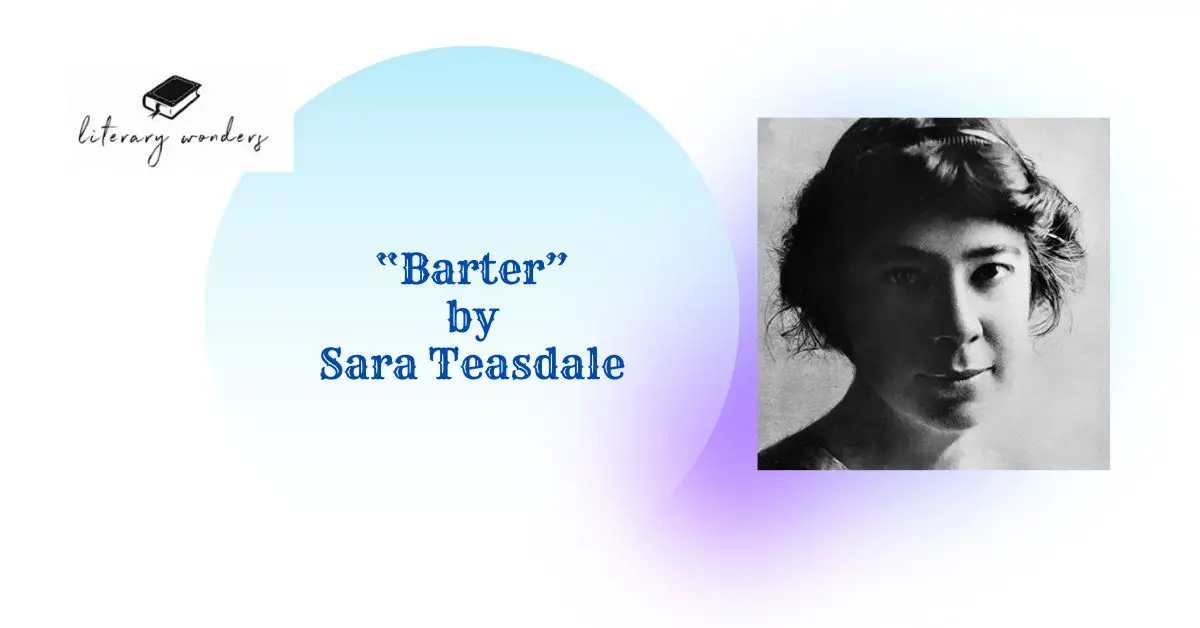Summary “Barter” by Sara Teasdale

- Introduction of “Barter”: Sara Teasdale, a promising American writer and poet, published the upbeat love song “Barter” in her collection in 1917. In this poem, she demonstrates the importance of living life to the fullest. She also emphasizes the necessity of maintaining joy. This poem’s unmatched reputation stems from the speaker’s method of listing the good things in life.
- “Barter” as an Encapsulation of Joy: The poem recounts the many blessings that life has to give. It starts with the speaker saying that life is full of lovely things because it has beauty to sell. She also mentions the gorgeous moments it has to offer. She begins by describing blue waves that turn white when they crash against the bluff. She then describes the soaring fire that sways and sings in the air. Another lovely moment she mentions is the children’s innocent faces gazing up at the sky. All of these images assist people in counting even the most insignificant blessings. In the second stanza, she introduces more joyful sensations that life has to give, such as the exceptional quality of music, which is described as being like a curve of gold. It also sells spiritual joys through positive thinking and excellent thoughts. As a result, she proposes that one devote all of one’s time to chasing loveliness.
- Major themes of “Barter”: The poem’s main themes include natural beauty, bounties, and hope. The speaker encourages her readers to be hopeful in their lives. According to her, one should count one’s blessings and be grateful. We might escape several tragedies in life if we focus on the good. Life is not always a bed of roses; it presents us with obstacles. However, it has many lovely things to offer, such as the hypnotic movement of ocean water, the fire that lights on winter nights, the innocent faces of children, and the holy ideas that light our hearts. According to her, one should spend all of one’s wealth on these delicacies and never consider the cost. In other words, she advises us to make the most of our lives.
Analysis of Literary Elements Used in The Poem
Literary devices are tools that writers use to help them create meaning in their basic poetry poems. Sara used some literary devices in the poem, which are discussed below.
- Assonance: Assonance is the repeating of vowel sounds in the same line, such as the sound of /e/ in “Life has loveliness to sell,” and the sound of /o/ in “They are both gone up to the church to pray.”
- Consonance: Consonance is the repeating of consonant sounds within the same line, such as /t/ in “Count many a year of strife well lost” and /n/ in “Scent of pine trees in the rain.”
- Diction: The poem uses descriptive diction, rhetorical tactics, symbolism, and powerful imagery.
- Enjambment: Enjambment is defined as an idea in verse that does not end with a line break but rather rolls over to the next line. As an example,
“And for a breath of ecstasy
Give all you have been, or could be.”
- End Rhyme: End rhyme is utilized to provide melody to the stanza. Sara used end rhymes in her poem such as “up/cup”, “hold/gold”, and “cost/lost.”
- Epigraph: A poem, quote, or line that is frequently inserted at the opening of a poem to suggest the overarching idea of the poem. Sara employs this device in the opening line, which reads, “Life has loveliness to sell.”
- Imagery: Imagery is used to persuade readers to perceive things through their five senses. In this poem, Sara uses images such as “Spend all you have for loveliness,” “Count many a year of strife well lost,” and “Give all you have been, or could be.”
- Metaphor: It is a figure of speech in which an inferred comparison is established between two dissimilar items in nature. In the poem, the poet uses life as an extended metaphor to explain how it provides miracles to the people.
- Repetition: The verse “Life has loveliness to sell” is repeated several times, giving the poem a melodic character.
- Refrain: The lines in the poems that are repeated at some distance are referred to as refrain. The verse “Life has loveliness to sell” is repeated with the same words, and it has become a refrain because it appears in two stanzas of the poem.
- Rhyme Scheme: The poem follows the ABCBDD rhyme scheme, which continues till the end.
- Stanza: A stanza is a poetic form comprising a few lines. This poem is divided into three stanzas, each of which contains six lines.
- Simile: A device used to compare something to something else in order to clarify concepts for readers. Sara employs this approach in the first stanza of the poem, where it is stated as follows:
“And children’s faces looking up
Holding wonder like a cup.”
- Symbolism: Symbolism is the use of symbols to represent ideas and attributes by imbuing them with symbolic meanings that differ from their literal meanings. The poem employs imagery such as awe, vitality, happiness, and loveliness.
FAQS about “Barter” by Sara Teasdale
Who is Sara Teasdale, and what is her background?
Sara Teasdale was an 1884 American poet. Her lyrical and emotive poetry frequently tackled topics of love, nature, and the human experience.
What is the poem “Barter” about?
“Barter” is a poem about the cost of living and the things individuals exchange for material gain. It implies that we frequently trade the simple pleasures of life for the quest of worldly riches.
When was “Barter” written?
“Barter” was written by Sara Teasdale and published in 1917 as part of her collection “Love Songs.”
What is the structure and form of the poem?
The poem “Barter” consists of three quatrains, followed by a simple rhyme scheme (ABAB). Also, it is written in free verse, meaning it lacks a regular rhyme or meter.
What are some of the key themes in “Barter”?
The major themes of “Barter” include the value of simple pleasures in life, blessings, and the idea that our time and experiences are precious.
What is the significance of the line “Life has loveliness to sell”?
This line signifies that life is full of beautiful and precious moments that can be enjoyed. It encourages readers to appreciate the simple and meaningful aspects of life.
What is the overall message or lesson of the poem?
The poem invites readers to appreciate the worth of life’s elusive and transient moments. It warns against sacrificing these times in search of worldly fortune because they are the genuine treasures.
What is the tone of the poem “Barter”?
The tone of the poem is contemplative and reflective. It encourages readers to pause and think about the choices they make in life and whether they are trading away meaningful experiences for material gain.
Suggested Readings

